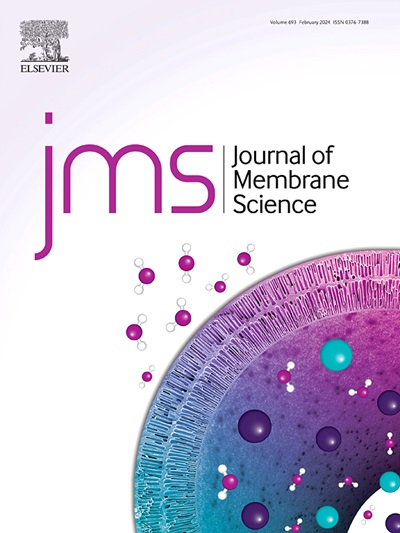原位交联制备抗污耐温聚酰胺纳滤膜的性能及表征
IF 8.4
1区 工程技术
Q1 ENGINEERING, CHEMICAL
引用次数: 0
摘要
膜的热稳定性已成为通过膜过滤在其原始温度下处理热工艺水的一个新兴的关键特征。受交联聚合物高热稳定性的启发,设计了酰胺基团,以增强选择层与支持层之间的化学相互作用,该支持层是由二乙烯三胺(DETA)修饰的交联内胶体PAN颗粒构建的,以增强选择层的热稳定性。通过化学相互作用,聚酰胺(PA)选择层的Tg由50.09℃提高到105.06℃。因此,PAN-DETA-C纳滤膜在90℃作用32 h时,其热稳定性为9.6 L m−2 h−1ꞏbar−1,对Na2SO4的吸收率为96.5%。其热稳定性主要源于其强大的交联链,这些交联链不仅在内部交联,而且在选择层中化学锚定在支撑层上。pan - delta -C对HA、BSA和SA的FRR为0.97-0.99,在90℃条件下具有优异的防污性能。本研究提出了一种利用商业材料,通过与商业纳滤膜剂量相同的制造工艺,构建热稳定纳滤膜的策略。本文章由计算机程序翻译,如有差异,请以英文原文为准。

Performance and characterization of in-situ cross-linking preparation of anti-fouling and temperature-resistant polyamide nanofiltration membranes
Thermal stability of membranes has become an emerging pivotal feature in treating hot process water at its original temperature through membrane filtration. Inspired by the highly thermal stability of cross-linked polymers, amide group was designed to enhance the chemical interaction between selective layer and support layer which was constructed by diethylenetriamine (DETA) modified intra-cross-linked colloidal PAN particles to reinforce the thermal stability of selective layer. The Tg of polyamide (PA) selective layers was elevated from 50.09 °C to 105.06 °C by the chemical interaction. Accordingly, the thermally stable PAN-DETA-C nanofiltration (NF) membrane exhibited stable permeance of 9.6 L m−2 h−1ꞏbar−1 and rejection to Na2SO4 of 96.5 % at 90 °C for 32 h. The thermal stability mainly stemmed from the robust cross-linked chains, which was not only intra-cross-linked but also was chemically anchored on support layer, in selective layer. Moreover, PAN-DETA-C exhibited excellent anti-fouling performance at 90 °C, where the FRR of 0.97–0.99 against HA, BSA, and SA was obtained. This study developed a strategy for constructing thermally stable NF membrane with commercial materials through the same manufacture process as commercial NF membrane dose.
求助全文
通过发布文献求助,成功后即可免费获取论文全文。
去求助
来源期刊

Journal of Membrane Science
工程技术-高分子科学
CiteScore
17.10
自引率
17.90%
发文量
1031
审稿时长
2.5 months
期刊介绍:
The Journal of Membrane Science is a publication that focuses on membrane systems and is aimed at academic and industrial chemists, chemical engineers, materials scientists, and membranologists. It publishes original research and reviews on various aspects of membrane transport, membrane formation/structure, fouling, module/process design, and processes/applications. The journal primarily focuses on the structure, function, and performance of non-biological membranes but also includes papers that relate to biological membranes. The Journal of Membrane Science publishes Full Text Papers, State-of-the-Art Reviews, Letters to the Editor, and Perspectives.
 求助内容:
求助内容: 应助结果提醒方式:
应助结果提醒方式:


